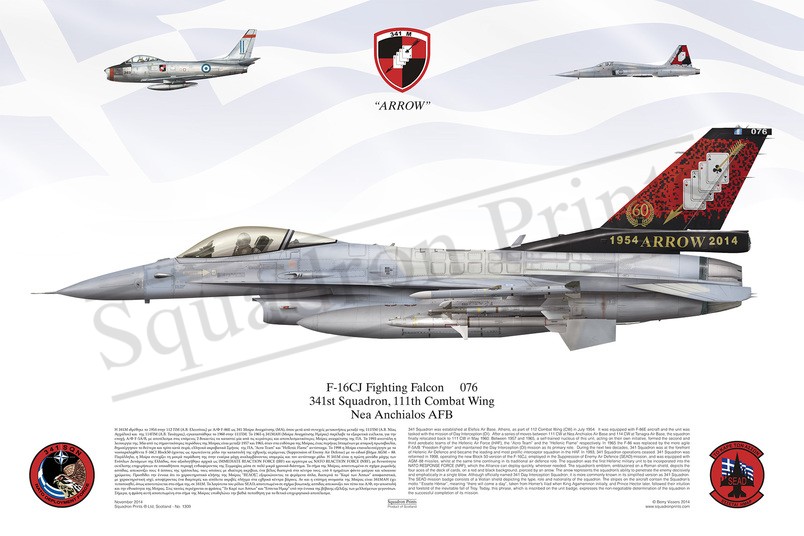#1309 F-16CJ Fighting Falcon

Purchased products will not feature the Squadron Prints watermark
Description
Squadron Prints Lithograph No. 1309 - F-16CJ Fighting Falcon, 076, 341 Squadron, 111 Combat Wing, Nea Anchialos AFB.
341 Squadron was established at Elefsis Air Base, Athens, as part of 112 Combat Wing (CW) in July 1954. It was equipped with F-86E aircraft and the unit was tasked with the mission of Day Interception (DI). After a series of moves between 111 CW at Nea Anchialos Air Base and 114 CW at Tanagra Air Base, the squadron finally relocated back to 111 CW in May 1960. Between 1957 and 1965, a self-trained nucleus of this unit, acting on their own initiative, formed the second and third aerobatic teams of the Hellenic Air Force (HAF), the “Acro Team” and the “Hellenic Flame” respectively. In 1965 the F-86 was replaced by the more agile F-5A/B “Freedom Fighter” and maintained the Day Interception (DI) mission as its primary role. During the next two decades, 341 Squadron was at the forefront of Hellenic Air Defence and became the leading and most prolific interceptor squadron in the HAF. In 1993, 341 Squadron operations ceased. 341 Squadron was reformed in 1998, operating the new Block 50 version of the F-16CJ, employed in the Suppression of Enemy Air Defence (SEAD) mission, and was equipped with AGM–88 missiles, whilst at the same time continuing in its traditional air defence role. The squadron was the first Hellenic military unit to be incorporated into the NATO RESPONSE FORCE (NRF), which the Alliance can deploy quickly, wherever needed. The squadron’s emblem, emblazoned on a Roman shield, depicts the four aces of the deck of cards, on a red and black background, pierced by an arrow. The arrow represents the squadron’s ability to penetrate the enemy decisively and emphatically in a single blow. Although officially named 341 Day Interception Squadron, it is more commonly known in its simplified version as 341 Squadron. The SEAD mission badge consists of a Viotian shield depicting the type, role and nationality of the squadron. The stripes on the aircraft contain the Squadron’s motto “’Essete Hémar”, meaning “there will come a day”, taken from Homer’s Iliad when King Agamemnon initially, and Prince Hector later, followed their intuition and foretold of the inevitable fall of Troy. Today, this phrase, which is inscribed on the unit badge, expresses the non-negotiable determination of the squadron in the successful completion of its mission.
